Systems Thinking: Critical Solutions for Tourism Trap Sustainability
VerifiedAdded on 2023/05/30
|10
|2503
|495
Essay
AI Summary
This essay examines the application of systems thinking to address the complex problem of the tourism trap in Europe. It begins by defining sustainability and systems thinking, highlighting the limitations of traditional problem-solving approaches when dealing with 'wicked problems' like sustainability. The essay then delves into the specific challenges posed by excessive tourism, including its impact on local populations, resources, and infrastructure. It proposes that a systems thinking approach, which considers the interconnectedness of various factors such as health, hygiene, and accommodation, can lead to more holistic and sustainable solutions. The essay concludes that by integrating the efforts of different departments and stakeholders, and by carefully managing tourist inflows, the negative impacts of over-tourism can be mitigated, ensuring a more sustainable future for both tourists and local residents. Desklib offers this assignment solution and many other resources for students.

Running head: SYSTEMS THINKING
Systems Thinking
Name of the Student:
Name of the University:
Author Note:
Systems Thinking
Name of the Student:
Name of the University:
Author Note:
Paraphrase This Document
Need a fresh take? Get an instant paraphrase of this document with our AI Paraphraser
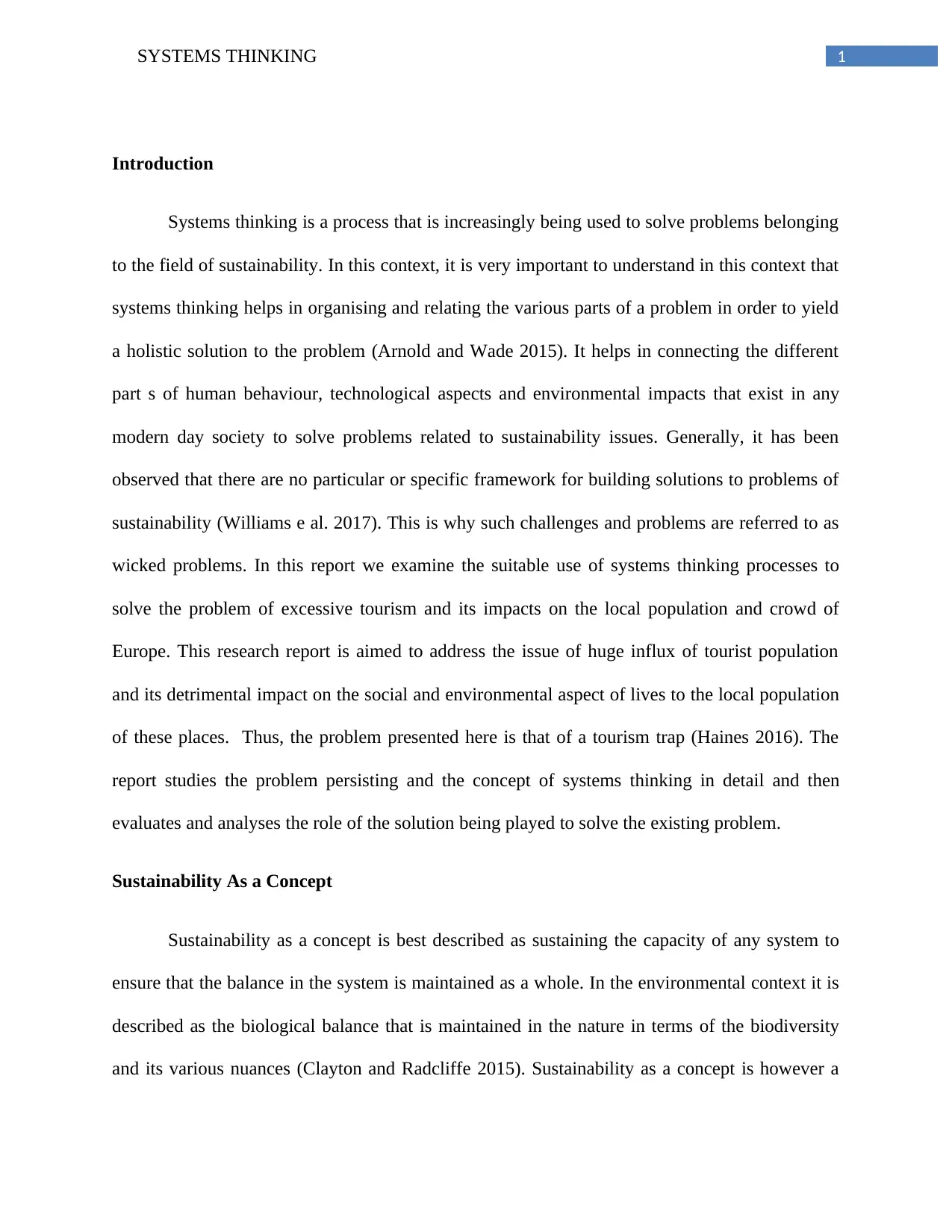
1SYSTEMS THINKING
Introduction
Systems thinking is a process that is increasingly being used to solve problems belonging
to the field of sustainability. In this context, it is very important to understand in this context that
systems thinking helps in organising and relating the various parts of a problem in order to yield
a holistic solution to the problem (Arnold and Wade 2015). It helps in connecting the different
part s of human behaviour, technological aspects and environmental impacts that exist in any
modern day society to solve problems related to sustainability issues. Generally, it has been
observed that there are no particular or specific framework for building solutions to problems of
sustainability (Williams e al. 2017). This is why such challenges and problems are referred to as
wicked problems. In this report we examine the suitable use of systems thinking processes to
solve the problem of excessive tourism and its impacts on the local population and crowd of
Europe. This research report is aimed to address the issue of huge influx of tourist population
and its detrimental impact on the social and environmental aspect of lives to the local population
of these places. Thus, the problem presented here is that of a tourism trap (Haines 2016). The
report studies the problem persisting and the concept of systems thinking in detail and then
evaluates and analyses the role of the solution being played to solve the existing problem.
Sustainability As a Concept
Sustainability as a concept is best described as sustaining the capacity of any system to
ensure that the balance in the system is maintained as a whole. In the environmental context it is
described as the biological balance that is maintained in the nature in terms of the biodiversity
and its various nuances (Clayton and Radcliffe 2015). Sustainability as a concept is however a
Introduction
Systems thinking is a process that is increasingly being used to solve problems belonging
to the field of sustainability. In this context, it is very important to understand in this context that
systems thinking helps in organising and relating the various parts of a problem in order to yield
a holistic solution to the problem (Arnold and Wade 2015). It helps in connecting the different
part s of human behaviour, technological aspects and environmental impacts that exist in any
modern day society to solve problems related to sustainability issues. Generally, it has been
observed that there are no particular or specific framework for building solutions to problems of
sustainability (Williams e al. 2017). This is why such challenges and problems are referred to as
wicked problems. In this report we examine the suitable use of systems thinking processes to
solve the problem of excessive tourism and its impacts on the local population and crowd of
Europe. This research report is aimed to address the issue of huge influx of tourist population
and its detrimental impact on the social and environmental aspect of lives to the local population
of these places. Thus, the problem presented here is that of a tourism trap (Haines 2016). The
report studies the problem persisting and the concept of systems thinking in detail and then
evaluates and analyses the role of the solution being played to solve the existing problem.
Sustainability As a Concept
Sustainability as a concept is best described as sustaining the capacity of any system to
ensure that the balance in the system is maintained as a whole. In the environmental context it is
described as the biological balance that is maintained in the nature in terms of the biodiversity
and its various nuances (Clayton and Radcliffe 2015). Sustainability as a concept is however a
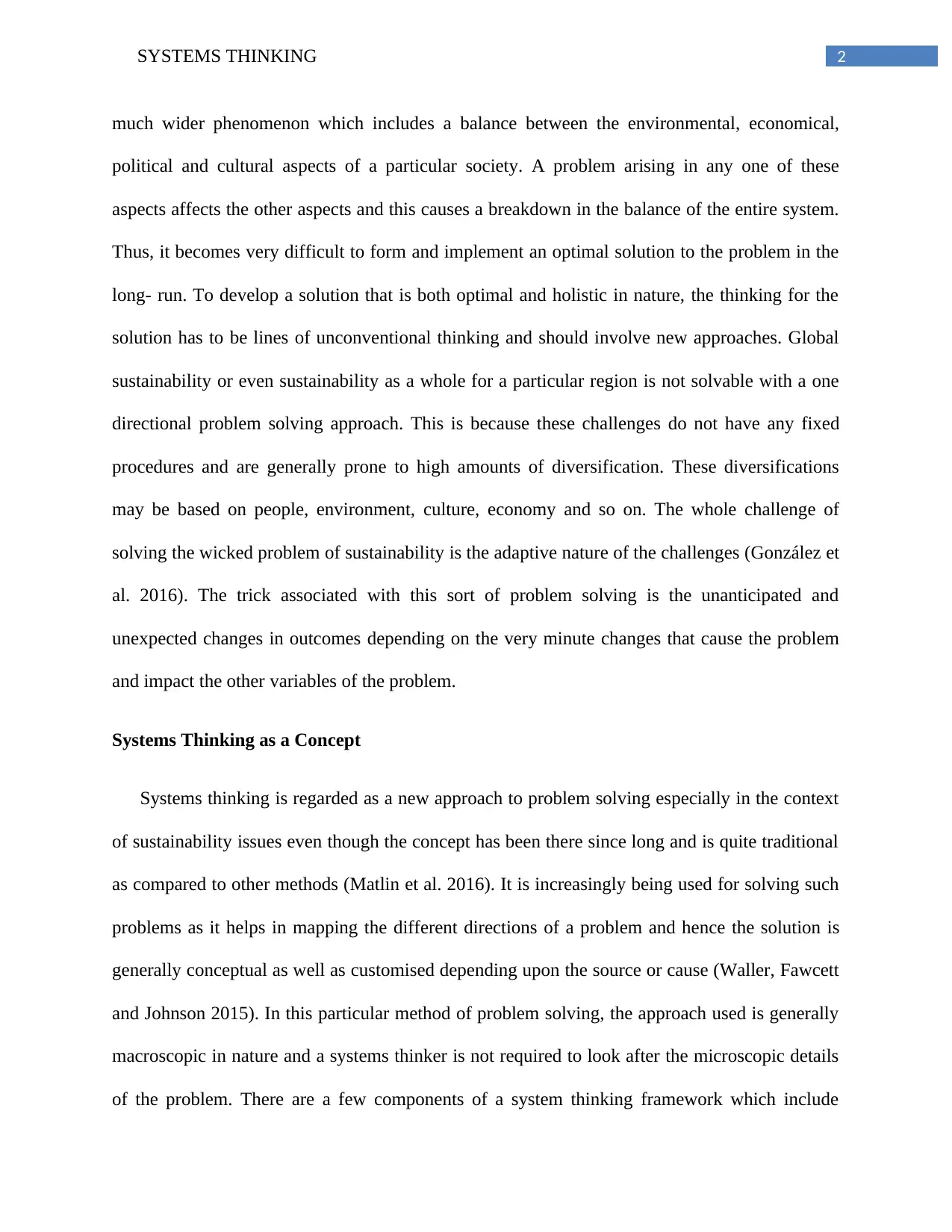
2SYSTEMS THINKING
much wider phenomenon which includes a balance between the environmental, economical,
political and cultural aspects of a particular society. A problem arising in any one of these
aspects affects the other aspects and this causes a breakdown in the balance of the entire system.
Thus, it becomes very difficult to form and implement an optimal solution to the problem in the
long- run. To develop a solution that is both optimal and holistic in nature, the thinking for the
solution has to be lines of unconventional thinking and should involve new approaches. Global
sustainability or even sustainability as a whole for a particular region is not solvable with a one
directional problem solving approach. This is because these challenges do not have any fixed
procedures and are generally prone to high amounts of diversification. These diversifications
may be based on people, environment, culture, economy and so on. The whole challenge of
solving the wicked problem of sustainability is the adaptive nature of the challenges (González et
al. 2016). The trick associated with this sort of problem solving is the unanticipated and
unexpected changes in outcomes depending on the very minute changes that cause the problem
and impact the other variables of the problem.
Systems Thinking as a Concept
Systems thinking is regarded as a new approach to problem solving especially in the context
of sustainability issues even though the concept has been there since long and is quite traditional
as compared to other methods (Matlin et al. 2016). It is increasingly being used for solving such
problems as it helps in mapping the different directions of a problem and hence the solution is
generally conceptual as well as customised depending upon the source or cause (Waller, Fawcett
and Johnson 2015). In this particular method of problem solving, the approach used is generally
macroscopic in nature and a systems thinker is not required to look after the microscopic details
of the problem. There are a few components of a system thinking framework which include
much wider phenomenon which includes a balance between the environmental, economical,
political and cultural aspects of a particular society. A problem arising in any one of these
aspects affects the other aspects and this causes a breakdown in the balance of the entire system.
Thus, it becomes very difficult to form and implement an optimal solution to the problem in the
long- run. To develop a solution that is both optimal and holistic in nature, the thinking for the
solution has to be lines of unconventional thinking and should involve new approaches. Global
sustainability or even sustainability as a whole for a particular region is not solvable with a one
directional problem solving approach. This is because these challenges do not have any fixed
procedures and are generally prone to high amounts of diversification. These diversifications
may be based on people, environment, culture, economy and so on. The whole challenge of
solving the wicked problem of sustainability is the adaptive nature of the challenges (González et
al. 2016). The trick associated with this sort of problem solving is the unanticipated and
unexpected changes in outcomes depending on the very minute changes that cause the problem
and impact the other variables of the problem.
Systems Thinking as a Concept
Systems thinking is regarded as a new approach to problem solving especially in the context
of sustainability issues even though the concept has been there since long and is quite traditional
as compared to other methods (Matlin et al. 2016). It is increasingly being used for solving such
problems as it helps in mapping the different directions of a problem and hence the solution is
generally conceptual as well as customised depending upon the source or cause (Waller, Fawcett
and Johnson 2015). In this particular method of problem solving, the approach used is generally
macroscopic in nature and a systems thinker is not required to look after the microscopic details
of the problem. There are a few components of a system thinking framework which include
⊘ This is a preview!⊘
Do you want full access?
Subscribe today to unlock all pages.

Trusted by 1+ million students worldwide
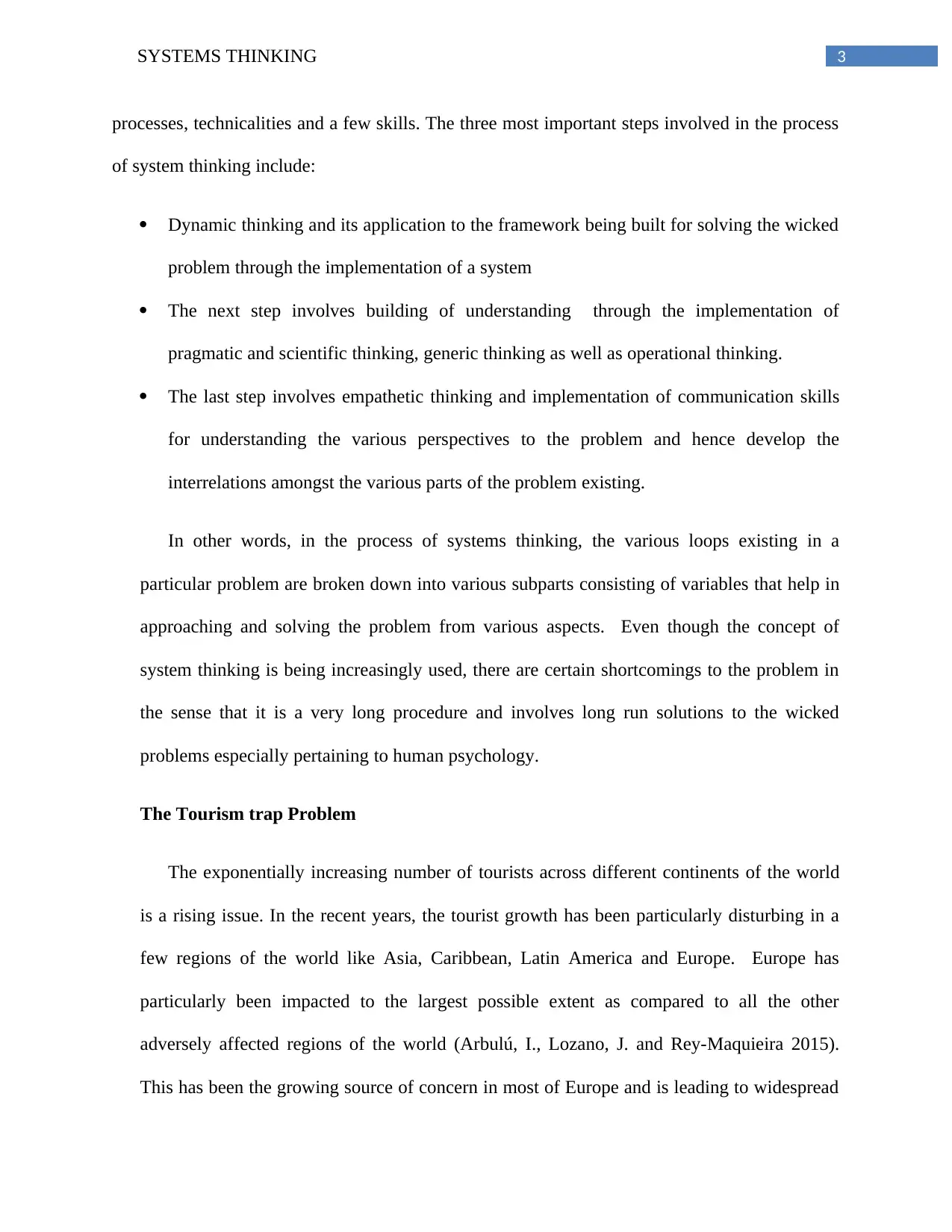
3SYSTEMS THINKING
processes, technicalities and a few skills. The three most important steps involved in the process
of system thinking include:
Dynamic thinking and its application to the framework being built for solving the wicked
problem through the implementation of a system
The next step involves building of understanding through the implementation of
pragmatic and scientific thinking, generic thinking as well as operational thinking.
The last step involves empathetic thinking and implementation of communication skills
for understanding the various perspectives to the problem and hence develop the
interrelations amongst the various parts of the problem existing.
In other words, in the process of systems thinking, the various loops existing in a
particular problem are broken down into various subparts consisting of variables that help in
approaching and solving the problem from various aspects. Even though the concept of
system thinking is being increasingly used, there are certain shortcomings to the problem in
the sense that it is a very long procedure and involves long run solutions to the wicked
problems especially pertaining to human psychology.
The Tourism trap Problem
The exponentially increasing number of tourists across different continents of the world
is a rising issue. In the recent years, the tourist growth has been particularly disturbing in a
few regions of the world like Asia, Caribbean, Latin America and Europe. Europe has
particularly been impacted to the largest possible extent as compared to all the other
adversely affected regions of the world (Arbulú, I., Lozano, J. and Rey-Maquieira 2015).
This has been the growing source of concern in most of Europe and is leading to widespread
processes, technicalities and a few skills. The three most important steps involved in the process
of system thinking include:
Dynamic thinking and its application to the framework being built for solving the wicked
problem through the implementation of a system
The next step involves building of understanding through the implementation of
pragmatic and scientific thinking, generic thinking as well as operational thinking.
The last step involves empathetic thinking and implementation of communication skills
for understanding the various perspectives to the problem and hence develop the
interrelations amongst the various parts of the problem existing.
In other words, in the process of systems thinking, the various loops existing in a
particular problem are broken down into various subparts consisting of variables that help in
approaching and solving the problem from various aspects. Even though the concept of
system thinking is being increasingly used, there are certain shortcomings to the problem in
the sense that it is a very long procedure and involves long run solutions to the wicked
problems especially pertaining to human psychology.
The Tourism trap Problem
The exponentially increasing number of tourists across different continents of the world
is a rising issue. In the recent years, the tourist growth has been particularly disturbing in a
few regions of the world like Asia, Caribbean, Latin America and Europe. Europe has
particularly been impacted to the largest possible extent as compared to all the other
adversely affected regions of the world (Arbulú, I., Lozano, J. and Rey-Maquieira 2015).
This has been the growing source of concern in most of Europe and is leading to widespread
Paraphrase This Document
Need a fresh take? Get an instant paraphrase of this document with our AI Paraphraser
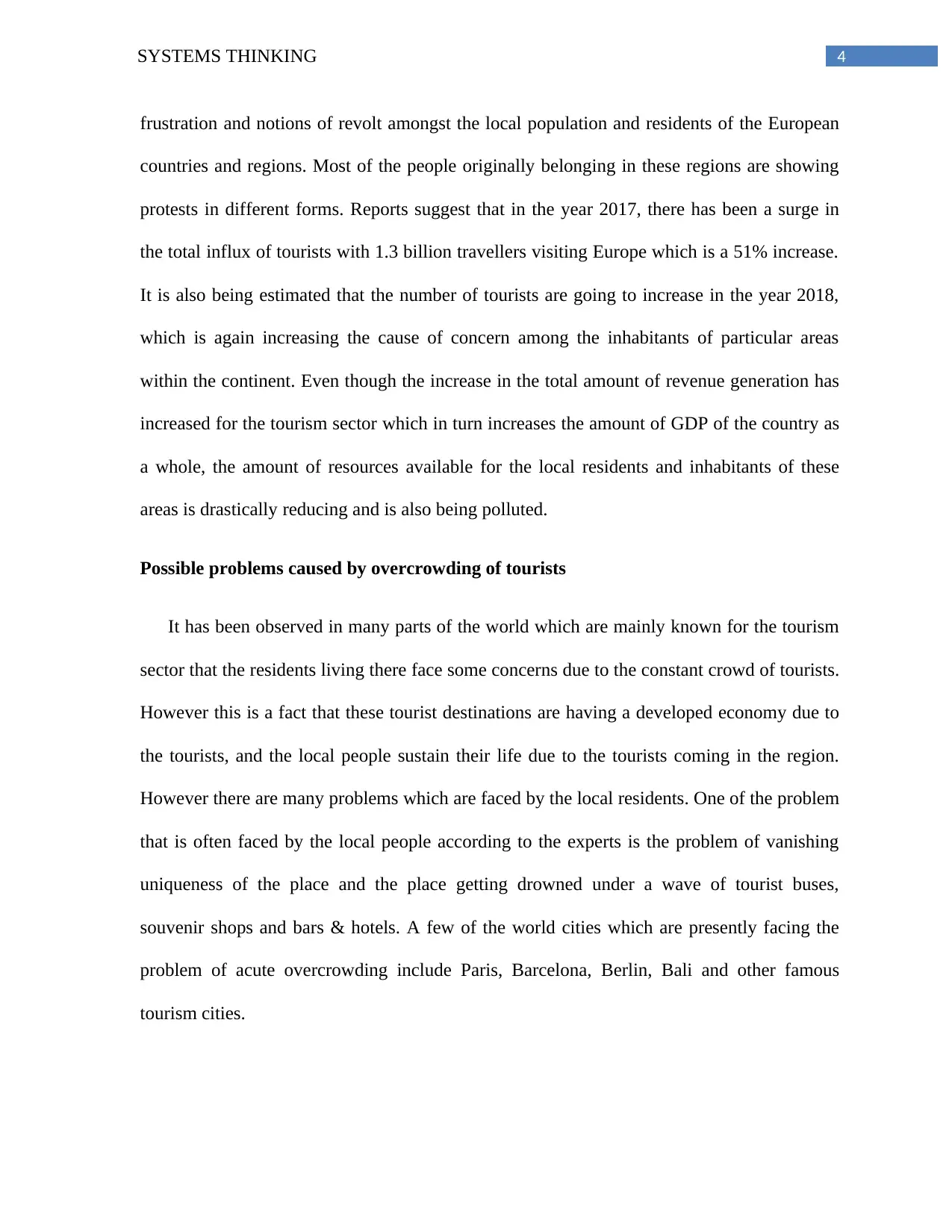
4SYSTEMS THINKING
frustration and notions of revolt amongst the local population and residents of the European
countries and regions. Most of the people originally belonging in these regions are showing
protests in different forms. Reports suggest that in the year 2017, there has been a surge in
the total influx of tourists with 1.3 billion travellers visiting Europe which is a 51% increase.
It is also being estimated that the number of tourists are going to increase in the year 2018,
which is again increasing the cause of concern among the inhabitants of particular areas
within the continent. Even though the increase in the total amount of revenue generation has
increased for the tourism sector which in turn increases the amount of GDP of the country as
a whole, the amount of resources available for the local residents and inhabitants of these
areas is drastically reducing and is also being polluted.
Possible problems caused by overcrowding of tourists
It has been observed in many parts of the world which are mainly known for the tourism
sector that the residents living there face some concerns due to the constant crowd of tourists.
However this is a fact that these tourist destinations are having a developed economy due to
the tourists, and the local people sustain their life due to the tourists coming in the region.
However there are many problems which are faced by the local residents. One of the problem
that is often faced by the local people according to the experts is the problem of vanishing
uniqueness of the place and the place getting drowned under a wave of tourist buses,
souvenir shops and bars & hotels. A few of the world cities which are presently facing the
problem of acute overcrowding include Paris, Barcelona, Berlin, Bali and other famous
tourism cities.
frustration and notions of revolt amongst the local population and residents of the European
countries and regions. Most of the people originally belonging in these regions are showing
protests in different forms. Reports suggest that in the year 2017, there has been a surge in
the total influx of tourists with 1.3 billion travellers visiting Europe which is a 51% increase.
It is also being estimated that the number of tourists are going to increase in the year 2018,
which is again increasing the cause of concern among the inhabitants of particular areas
within the continent. Even though the increase in the total amount of revenue generation has
increased for the tourism sector which in turn increases the amount of GDP of the country as
a whole, the amount of resources available for the local residents and inhabitants of these
areas is drastically reducing and is also being polluted.
Possible problems caused by overcrowding of tourists
It has been observed in many parts of the world which are mainly known for the tourism
sector that the residents living there face some concerns due to the constant crowd of tourists.
However this is a fact that these tourist destinations are having a developed economy due to
the tourists, and the local people sustain their life due to the tourists coming in the region.
However there are many problems which are faced by the local residents. One of the problem
that is often faced by the local people according to the experts is the problem of vanishing
uniqueness of the place and the place getting drowned under a wave of tourist buses,
souvenir shops and bars & hotels. A few of the world cities which are presently facing the
problem of acute overcrowding include Paris, Barcelona, Berlin, Bali and other famous
tourism cities.
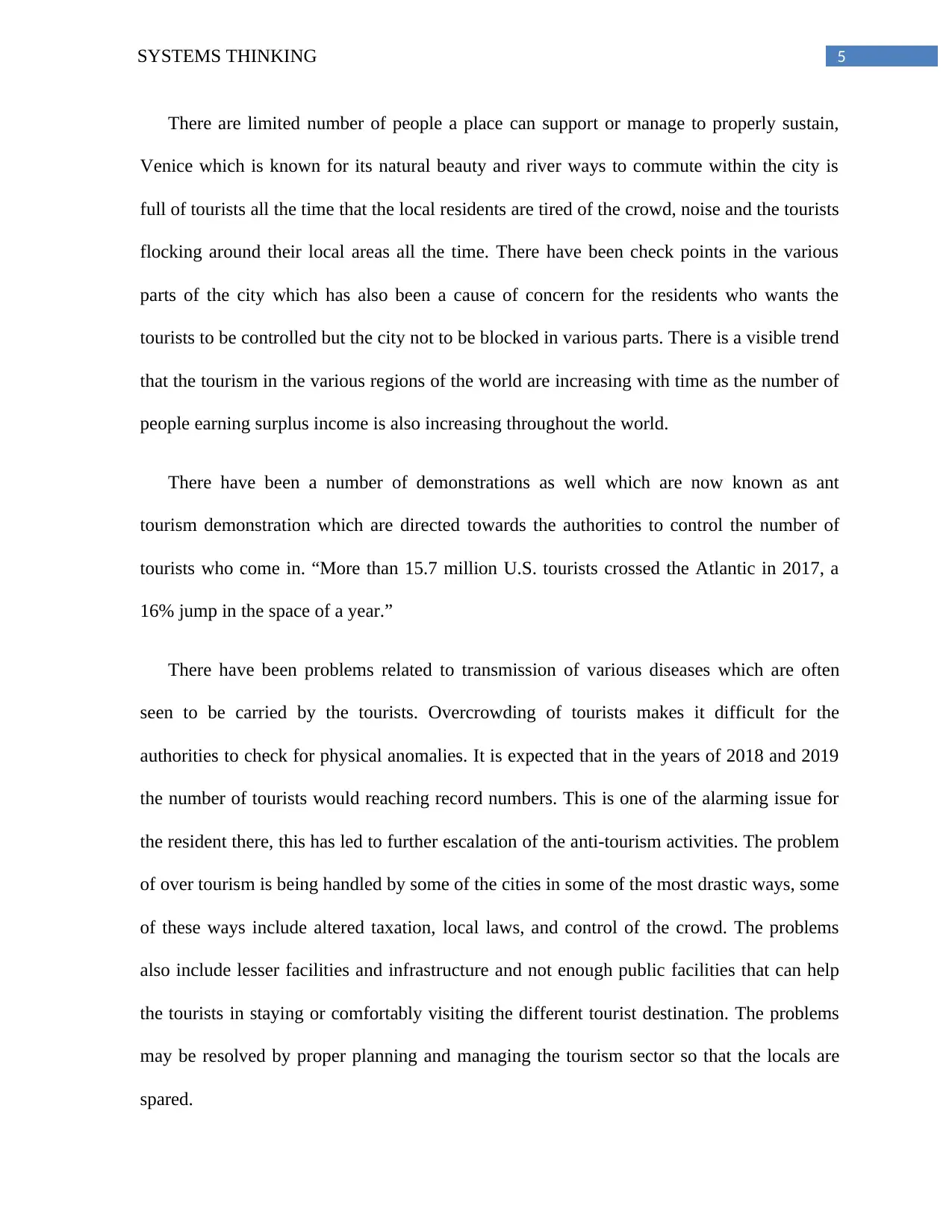
5SYSTEMS THINKING
There are limited number of people a place can support or manage to properly sustain,
Venice which is known for its natural beauty and river ways to commute within the city is
full of tourists all the time that the local residents are tired of the crowd, noise and the tourists
flocking around their local areas all the time. There have been check points in the various
parts of the city which has also been a cause of concern for the residents who wants the
tourists to be controlled but the city not to be blocked in various parts. There is a visible trend
that the tourism in the various regions of the world are increasing with time as the number of
people earning surplus income is also increasing throughout the world.
There have been a number of demonstrations as well which are now known as ant
tourism demonstration which are directed towards the authorities to control the number of
tourists who come in. “More than 15.7 million U.S. tourists crossed the Atlantic in 2017, a
16% jump in the space of a year.”
There have been problems related to transmission of various diseases which are often
seen to be carried by the tourists. Overcrowding of tourists makes it difficult for the
authorities to check for physical anomalies. It is expected that in the years of 2018 and 2019
the number of tourists would reaching record numbers. This is one of the alarming issue for
the resident there, this has led to further escalation of the anti-tourism activities. The problem
of over tourism is being handled by some of the cities in some of the most drastic ways, some
of these ways include altered taxation, local laws, and control of the crowd. The problems
also include lesser facilities and infrastructure and not enough public facilities that can help
the tourists in staying or comfortably visiting the different tourist destination. The problems
may be resolved by proper planning and managing the tourism sector so that the locals are
spared.
There are limited number of people a place can support or manage to properly sustain,
Venice which is known for its natural beauty and river ways to commute within the city is
full of tourists all the time that the local residents are tired of the crowd, noise and the tourists
flocking around their local areas all the time. There have been check points in the various
parts of the city which has also been a cause of concern for the residents who wants the
tourists to be controlled but the city not to be blocked in various parts. There is a visible trend
that the tourism in the various regions of the world are increasing with time as the number of
people earning surplus income is also increasing throughout the world.
There have been a number of demonstrations as well which are now known as ant
tourism demonstration which are directed towards the authorities to control the number of
tourists who come in. “More than 15.7 million U.S. tourists crossed the Atlantic in 2017, a
16% jump in the space of a year.”
There have been problems related to transmission of various diseases which are often
seen to be carried by the tourists. Overcrowding of tourists makes it difficult for the
authorities to check for physical anomalies. It is expected that in the years of 2018 and 2019
the number of tourists would reaching record numbers. This is one of the alarming issue for
the resident there, this has led to further escalation of the anti-tourism activities. The problem
of over tourism is being handled by some of the cities in some of the most drastic ways, some
of these ways include altered taxation, local laws, and control of the crowd. The problems
also include lesser facilities and infrastructure and not enough public facilities that can help
the tourists in staying or comfortably visiting the different tourist destination. The problems
may be resolved by proper planning and managing the tourism sector so that the locals are
spared.
⊘ This is a preview!⊘
Do you want full access?
Subscribe today to unlock all pages.

Trusted by 1+ million students worldwide
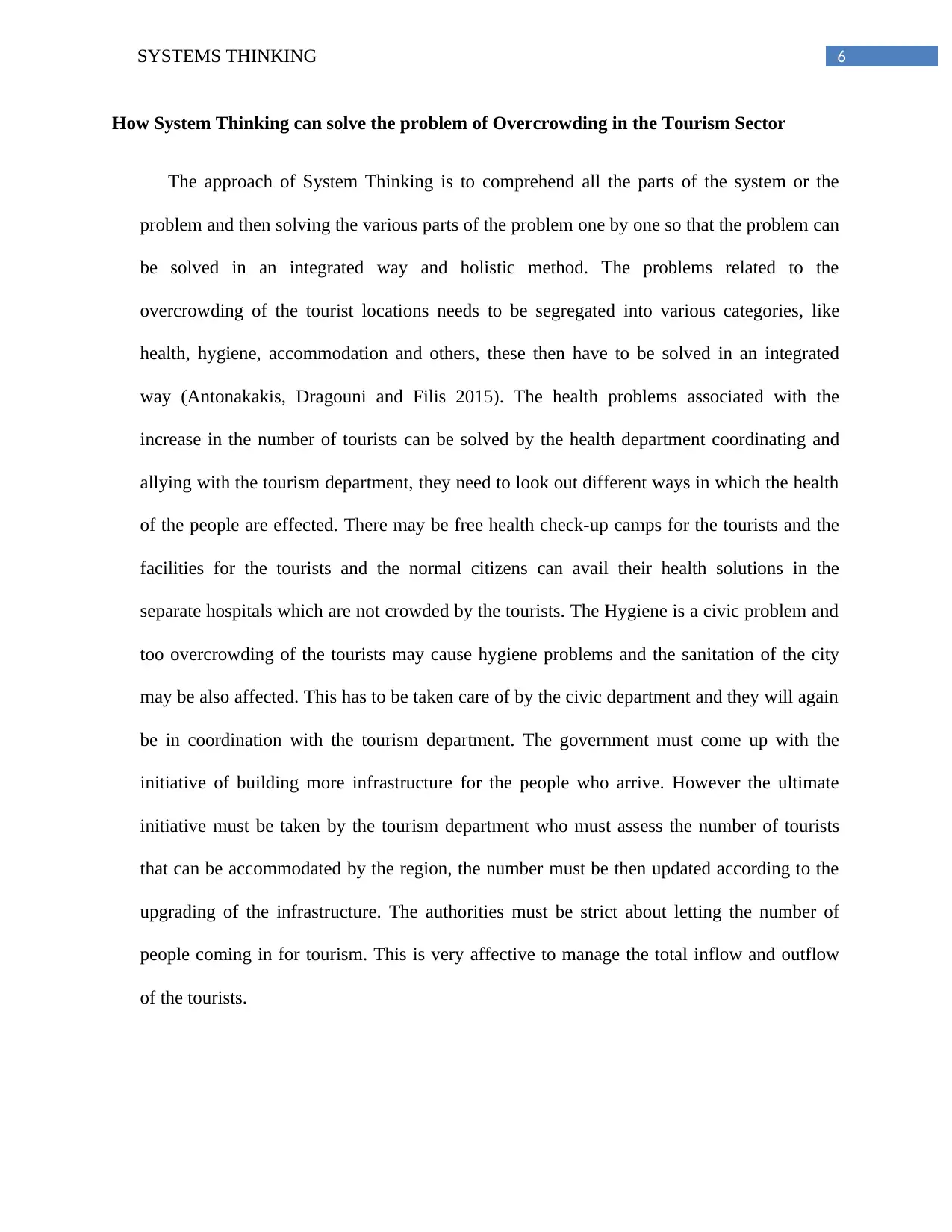
6SYSTEMS THINKING
How System Thinking can solve the problem of Overcrowding in the Tourism Sector
The approach of System Thinking is to comprehend all the parts of the system or the
problem and then solving the various parts of the problem one by one so that the problem can
be solved in an integrated way and holistic method. The problems related to the
overcrowding of the tourist locations needs to be segregated into various categories, like
health, hygiene, accommodation and others, these then have to be solved in an integrated
way (Antonakakis, Dragouni and Filis 2015). The health problems associated with the
increase in the number of tourists can be solved by the health department coordinating and
allying with the tourism department, they need to look out different ways in which the health
of the people are effected. There may be free health check-up camps for the tourists and the
facilities for the tourists and the normal citizens can avail their health solutions in the
separate hospitals which are not crowded by the tourists. The Hygiene is a civic problem and
too overcrowding of the tourists may cause hygiene problems and the sanitation of the city
may be also affected. This has to be taken care of by the civic department and they will again
be in coordination with the tourism department. The government must come up with the
initiative of building more infrastructure for the people who arrive. However the ultimate
initiative must be taken by the tourism department who must assess the number of tourists
that can be accommodated by the region, the number must be then updated according to the
upgrading of the infrastructure. The authorities must be strict about letting the number of
people coming in for tourism. This is very affective to manage the total inflow and outflow
of the tourists.
How System Thinking can solve the problem of Overcrowding in the Tourism Sector
The approach of System Thinking is to comprehend all the parts of the system or the
problem and then solving the various parts of the problem one by one so that the problem can
be solved in an integrated way and holistic method. The problems related to the
overcrowding of the tourist locations needs to be segregated into various categories, like
health, hygiene, accommodation and others, these then have to be solved in an integrated
way (Antonakakis, Dragouni and Filis 2015). The health problems associated with the
increase in the number of tourists can be solved by the health department coordinating and
allying with the tourism department, they need to look out different ways in which the health
of the people are effected. There may be free health check-up camps for the tourists and the
facilities for the tourists and the normal citizens can avail their health solutions in the
separate hospitals which are not crowded by the tourists. The Hygiene is a civic problem and
too overcrowding of the tourists may cause hygiene problems and the sanitation of the city
may be also affected. This has to be taken care of by the civic department and they will again
be in coordination with the tourism department. The government must come up with the
initiative of building more infrastructure for the people who arrive. However the ultimate
initiative must be taken by the tourism department who must assess the number of tourists
that can be accommodated by the region, the number must be then updated according to the
upgrading of the infrastructure. The authorities must be strict about letting the number of
people coming in for tourism. This is very affective to manage the total inflow and outflow
of the tourists.
Paraphrase This Document
Need a fresh take? Get an instant paraphrase of this document with our AI Paraphraser
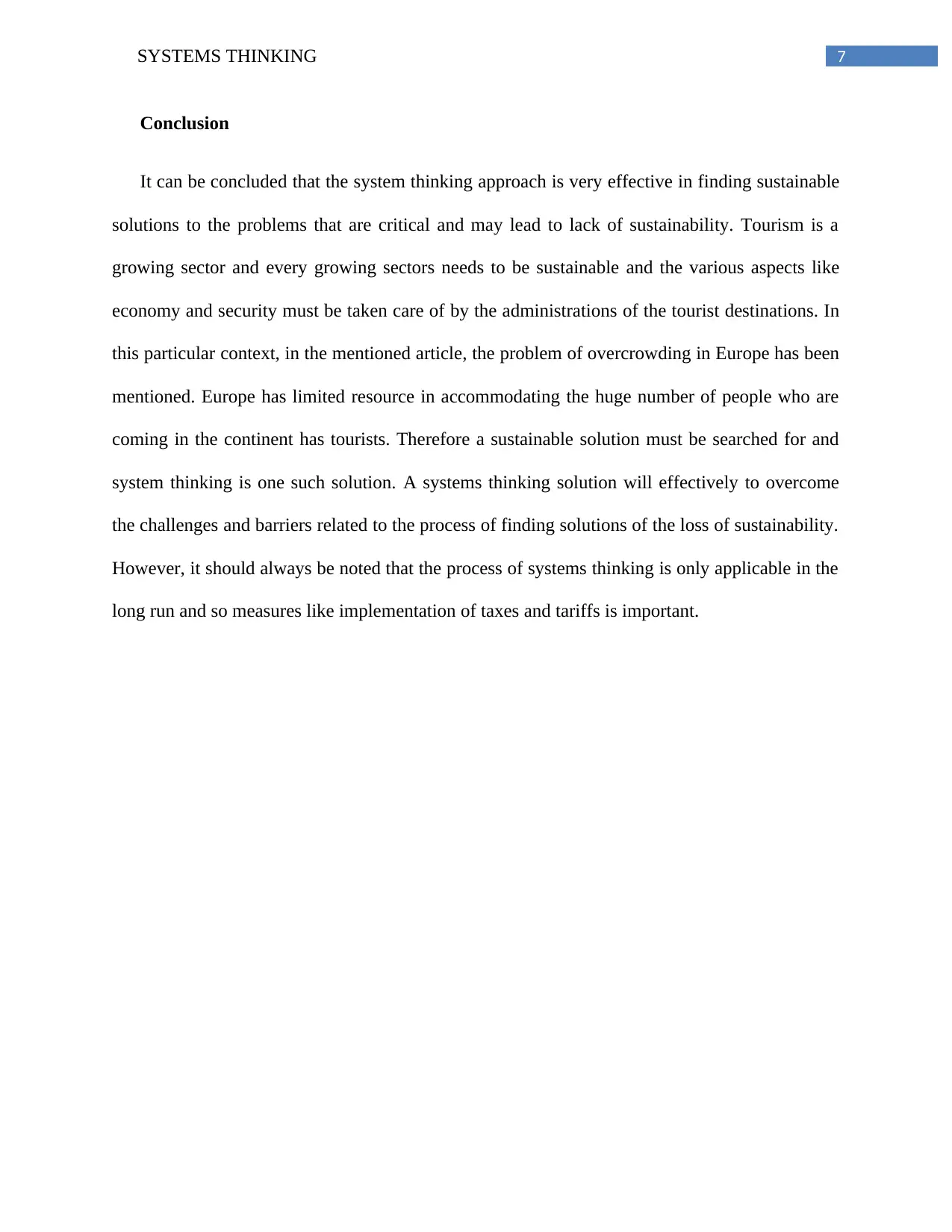
7SYSTEMS THINKING
Conclusion
It can be concluded that the system thinking approach is very effective in finding sustainable
solutions to the problems that are critical and may lead to lack of sustainability. Tourism is a
growing sector and every growing sectors needs to be sustainable and the various aspects like
economy and security must be taken care of by the administrations of the tourist destinations. In
this particular context, in the mentioned article, the problem of overcrowding in Europe has been
mentioned. Europe has limited resource in accommodating the huge number of people who are
coming in the continent has tourists. Therefore a sustainable solution must be searched for and
system thinking is one such solution. A systems thinking solution will effectively to overcome
the challenges and barriers related to the process of finding solutions of the loss of sustainability.
However, it should always be noted that the process of systems thinking is only applicable in the
long run and so measures like implementation of taxes and tariffs is important.
Conclusion
It can be concluded that the system thinking approach is very effective in finding sustainable
solutions to the problems that are critical and may lead to lack of sustainability. Tourism is a
growing sector and every growing sectors needs to be sustainable and the various aspects like
economy and security must be taken care of by the administrations of the tourist destinations. In
this particular context, in the mentioned article, the problem of overcrowding in Europe has been
mentioned. Europe has limited resource in accommodating the huge number of people who are
coming in the continent has tourists. Therefore a sustainable solution must be searched for and
system thinking is one such solution. A systems thinking solution will effectively to overcome
the challenges and barriers related to the process of finding solutions of the loss of sustainability.
However, it should always be noted that the process of systems thinking is only applicable in the
long run and so measures like implementation of taxes and tariffs is important.
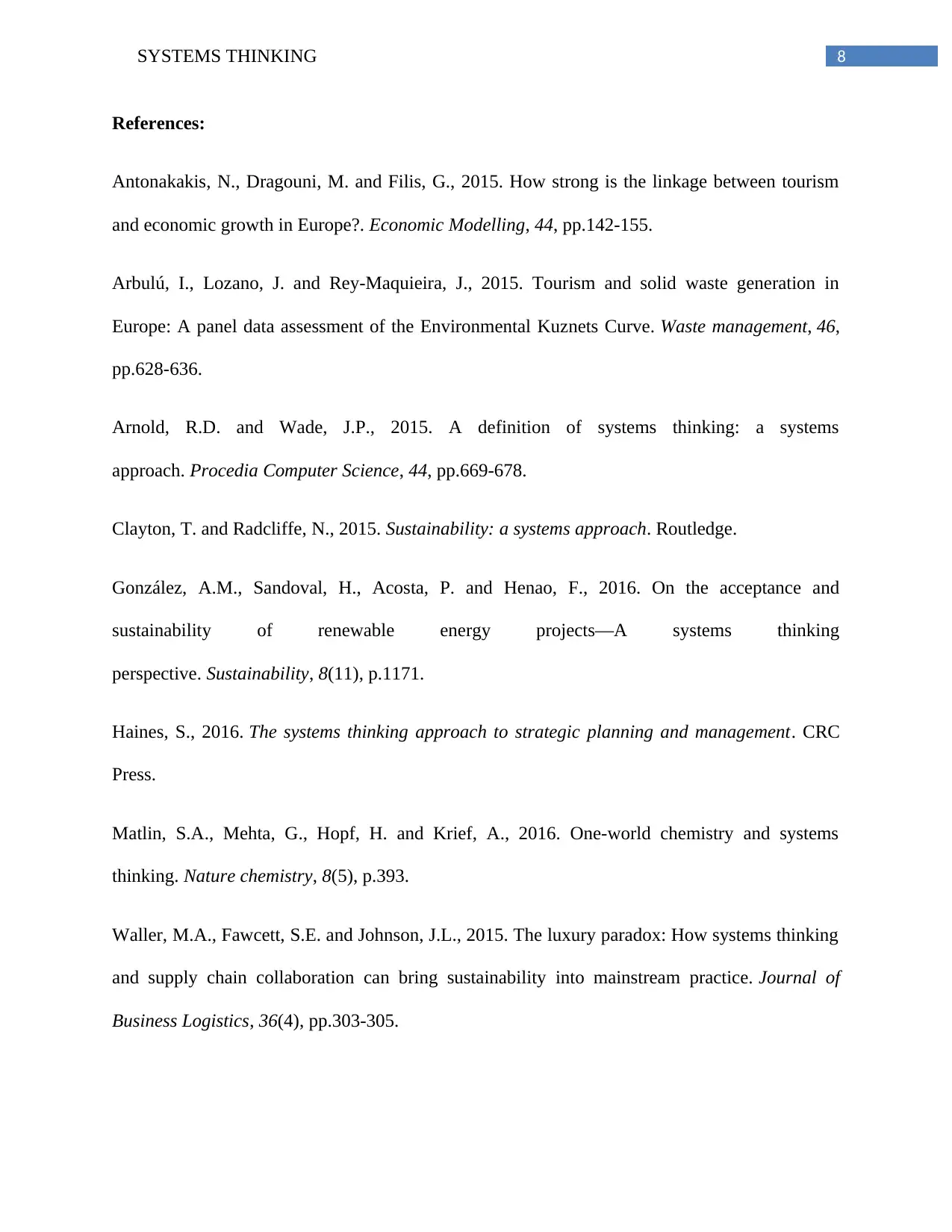
8SYSTEMS THINKING
References:
Antonakakis, N., Dragouni, M. and Filis, G., 2015. How strong is the linkage between tourism
and economic growth in Europe?. Economic Modelling, 44, pp.142-155.
Arbulú, I., Lozano, J. and Rey-Maquieira, J., 2015. Tourism and solid waste generation in
Europe: A panel data assessment of the Environmental Kuznets Curve. Waste management, 46,
pp.628-636.
Arnold, R.D. and Wade, J.P., 2015. A definition of systems thinking: a systems
approach. Procedia Computer Science, 44, pp.669-678.
Clayton, T. and Radcliffe, N., 2015. Sustainability: a systems approach. Routledge.
González, A.M., Sandoval, H., Acosta, P. and Henao, F., 2016. On the acceptance and
sustainability of renewable energy projects—A systems thinking
perspective. Sustainability, 8(11), p.1171.
Haines, S., 2016. The systems thinking approach to strategic planning and management. CRC
Press.
Matlin, S.A., Mehta, G., Hopf, H. and Krief, A., 2016. One-world chemistry and systems
thinking. Nature chemistry, 8(5), p.393.
Waller, M.A., Fawcett, S.E. and Johnson, J.L., 2015. The luxury paradox: How systems thinking
and supply chain collaboration can bring sustainability into mainstream practice. Journal of
Business Logistics, 36(4), pp.303-305.
References:
Antonakakis, N., Dragouni, M. and Filis, G., 2015. How strong is the linkage between tourism
and economic growth in Europe?. Economic Modelling, 44, pp.142-155.
Arbulú, I., Lozano, J. and Rey-Maquieira, J., 2015. Tourism and solid waste generation in
Europe: A panel data assessment of the Environmental Kuznets Curve. Waste management, 46,
pp.628-636.
Arnold, R.D. and Wade, J.P., 2015. A definition of systems thinking: a systems
approach. Procedia Computer Science, 44, pp.669-678.
Clayton, T. and Radcliffe, N., 2015. Sustainability: a systems approach. Routledge.
González, A.M., Sandoval, H., Acosta, P. and Henao, F., 2016. On the acceptance and
sustainability of renewable energy projects—A systems thinking
perspective. Sustainability, 8(11), p.1171.
Haines, S., 2016. The systems thinking approach to strategic planning and management. CRC
Press.
Matlin, S.A., Mehta, G., Hopf, H. and Krief, A., 2016. One-world chemistry and systems
thinking. Nature chemistry, 8(5), p.393.
Waller, M.A., Fawcett, S.E. and Johnson, J.L., 2015. The luxury paradox: How systems thinking
and supply chain collaboration can bring sustainability into mainstream practice. Journal of
Business Logistics, 36(4), pp.303-305.
⊘ This is a preview!⊘
Do you want full access?
Subscribe today to unlock all pages.

Trusted by 1+ million students worldwide

9SYSTEMS THINKING
Williams, A., Kennedy, S., Philipp, F. and Whiteman, G., 2017. Systems thinking: A review of
sustainability management research. Journal of Cleaner Production, 148, pp.866-881.
Williams, A., Kennedy, S., Philipp, F. and Whiteman, G., 2017. Systems thinking: A review of
sustainability management research. Journal of Cleaner Production, 148, pp.866-881.
1 out of 10
Related Documents
Your All-in-One AI-Powered Toolkit for Academic Success.
+13062052269
info@desklib.com
Available 24*7 on WhatsApp / Email
![[object Object]](/_next/static/media/star-bottom.7253800d.svg)
Unlock your academic potential
Copyright © 2020–2025 A2Z Services. All Rights Reserved. Developed and managed by ZUCOL.




